Cultural Studies I - 59-208-201-f10
advertisement
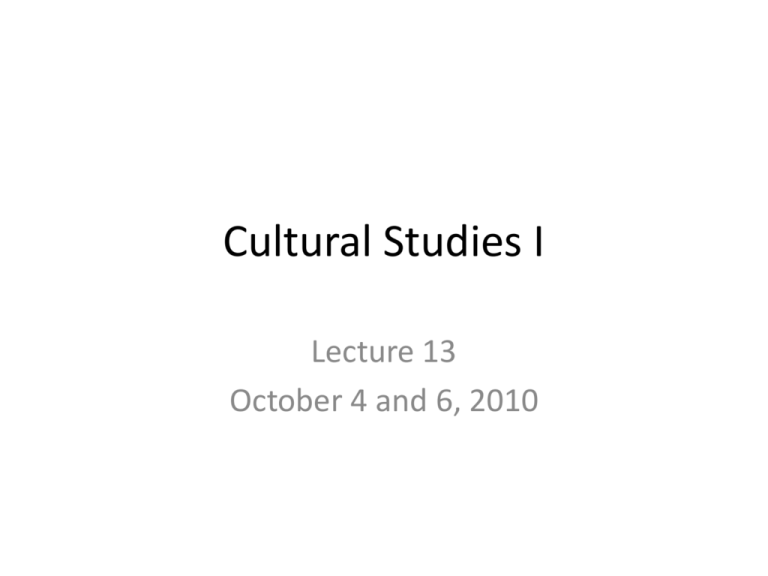
Cultural Studies I Lecture 13 October 4 and 6, 2010 Golden Age Athens -began with the Athenian defeat of the Persians in 480 BCE, ended 80 years later when Athens fell to Sparta -When Athens fell, the classical period continued across dynasties through what we call the ‘Hellenistic’ period (from the verb to ‘Hellenize’ or spread Greek culture) According to the textbook, the so-called ‘Athenian Golden Age’ is considered a period of unsurpassed cultural achievement. Why is this? What is problematic about called the Athenian Golden Age a period of ‘unsurpassed cultural achievement’? According to the textbook, the so-called ‘Athenian Golden Age’ is considered a period of unsurpassed cultural achievement. Why is this? • Forms the basis of many western traditions • First comprehensive code of laws – offered a single standard of justice to all Athenians, rich or poor • Different classes of people had the right to participate in debates in the political Assembly • Invention of jury duty (supposedly for all citizens) • Political representation and elections – beginnings of the concept of democracy (although MUCH room for improvement as many were excluded) • Produced a body of philosophical thought that influenced later European inquiry for centuries, specifically: – The relationship between individual freedom and civic responsibility – The harmony between the natural world and the intellectual realm • Developed sophisticated theater, harmonious and balanced architecture that has been widely imitated What is problematic about called the Athenian Golden Age a period of ‘unsurpassed cultural achievement’? What are some of the reasons as to why Athens emerged as a cultural center in the 5th century BCE? • • • • • Political reform – first code of laws Debt slavery ended Many artists and artisans were employed by the state Trade was promoted, particularly in pottery Redistribution of large estates of some nobility to landless farmers, who were then able to vote (as only land owners could vote) • Beginnings of representative democracy Athens was built on a hilly site which symbolized the abode of the gods and was strategic for defense Architecture of the Golden Age of Athens • Athens was a major city in ancient times, centered around an acropolis (akros = high, polis = city) – An acropolis is a citadel built on high land for strategic purposes and are found throughout the ancient Mediterranean • On the acropolis, there were temples, law courts, shrines, athletic facilities – all of which were destroyed by Persians in 480 BCE and later rebuilt • As part of the rebuilding process, the people of Athens built a temple to the goddess Athena, who they believed helped the Romans defeat the Persians • The state hired the best artists and artisans – over 22,000 tons of marble used After the Persian invasion of Greece in 480 BCE, Athenians had vowed to keep the Acropolis in a state of ruin as a reminder of the horrible price of war. However, Pericles convinced them to rebuilt it. But who actually rebuilt it? -the Athenian democracy was built on slavery -in the middle of the Golden Age, the population of Athens was 275,000 – only 40,000 of which were citizens! -between 80,000 and 100,000 were slaves (‘barbarians’, the word Greeks used for non-Greek-speaking people – by definition inferior) Acropolis, Athens Euripides: “Nothing is worse for a city than a tyrant. One man rules, and frames the law himself. Equality doesn’t exist. But when laws are written down, both rich and poor have the same right to justice. This is freedom’s rallying cry: “…when the people are the pilots of the city, they control their own destiny”. •What exactly does this mean? •How is this philosophy different from ancient Egyptians or Mesopotamians? •What specific feature of the Acropolis emerged to accommodate this philosophy? Parthenon and Agora http://www.youtube.com/watch?v=HYSV6Bg8O0 Stoa of Attalos, Athens, Greece, 150 BCE -the principal architectural feature of the agora was the stoa, a long, open arcade supported by colonnades, or rows of columns • • • • • The Parthenon itself replaced an older temple of Athena, which historians call the Pre-Parthenon or Older Parthenon – destroyed in the Persian invasion of 480 BCE Like most Greek temples, the Parthenon was used as a treasury Converted to a Christian church in the 6th century CE dedicated to the Virgin Mary After the conquest of the Ottoman Turks, it was turned into a mosque in the early 1460s,and had a minaret built in it. The structure and sculptures were badly destroyed when the Ottomans stored ammunition in it, which was ignited by Venetians. Lord Elgin, a British earl, removed most of the surviving sculptures In 1806, with the Ottoman Turks' permission. These are now called the ‘Elgin marbles’, which Greece is fighting to get back. • http://www.youtube.com/watch?v=vzhA3yiEofI (Optical Tricks of the Parthenon) • http://www.youtube.com/watch?v=ASdYVEIDXnM&feature=r elated (3D Acropolis) Sculpture on the Parthenon Lapith and Centaur, Parthenon, 440 BCE The struggle of the Lapiths against the Centaurs served the Greeks as a metaphor for the conflict between the civilized and barbaric. Procession of Women, Parthenon, 440 BC Kritios Boy, 480 BCE -transitional piece, from stiff earlier sculpture to a more naturalistic style -’engaged’ leg Aphrodite of Knidos The Scraper -ideal male nude: slender proportions -intended to be seen from all sides Ancient Greek theatres -built into hillsides, unlike free-standing Roman theatres -could seat up to 15,000 people Hellenistic Greece • Corresponds to the period between the death of Alexander the Great in 323 BCE and the annexation of Rome in 146 BCE, after which Greece became a province of the Roman Empire • During the Hellenistic period, what is now the country of Greece was not the key region – the great centers of Hellenistic culture were Alexandria (Egypt), Ephesus (Turkey) and Antioch (Syria) • Alexander secured vast territories to which many ambitious young Greeks moved (Alexandria and other Mediterranean cities, but even as far as Afghanistan and Pakistan) • Alexander’s vast territory spread Greek culture across a massive geographical area Who was Alexander the Great? •A Macedonian who may not have understood the language of Athens •An ambitious soldier •While not Greek, his family shared a deep love of Greek culture and civilization •Alexander’s father was King Philip of Macedonia •Philip united all of Greece (338 BCE), except Sparta •Alexander was jealous of his father’s success and aimed to outshine him by conquering more territory •In preparing for battle against the Persians, Philip is assassinated and at age 19 Alexander becomes King of Macedonia •Philip had just divorced Alexander’s mother and removed him from any role in government Alexander was a merciless fighter – his mother claimed he was descended from the great Greek god Hercules and the greatest Greek soldier of all time, Achilles When he took over the Greek city of Thebes (in Egypt) revolted – Alexander responded by destroying the city and selling the entire population into slavery Payback time for the Persians – but first…. •Alexander conquers Egypt, Mesopotamia where he takes Babylon with no resistance •Takes Persepolis, the Persian capital, takes the city’s treasures, then burns it •Enters present-day Pakistan •Alexander sought to conquer India, which he assumed was small •Along the way, Alexander established many new cities and named many of them after himself •Alexander believed if he continued east, he would hit what he called ‘Ocean’, which would take him back to Greece. What does this indicate about ancient Greek geography? •What stopped Alexander from conquering India? Payback time for the Persians – but first…. •Alexander conquers Egypt, Mesopotamia where he takes Babylon with no resistance •Takes Persepolis, the Persian capital, takes the city’s treasures, then burns it •Enters present-day Pakistan •Alexander sought to conquer India, which he assumed was small •Along the way, Alexander established many new cities and named many of them after himself •Alexander believed if he continued east, he would hit what he called ‘Ocean’, which would take him back to Greece. What does this indicate about ancient Greek geography? •What stopped Alexander from conquering India? Cultural influences of Alexander beyond the Mediterranean • Even during Alexander’s lifetime, the eastern edges of his empire began to disintegrate. However, it left a vacuum of power, allowing a great Indian empire to form • Greek town planning spread beyond Greece • Hellenistic art Hellenistic influence in India: •Greek Corinthian columns feature Buddha •Greek coin on which the king is featured wearing an elephant scalp to symbolize the conquest of India •The Buddha takes on Greek features: thick wavy hair, long straight nose, etc Lysippus: Sculptor of Heroes •Alexander’s chief sculptor (4 century BCE) •Many sculptures of Alexander were made to commemorate him as a Greek hero – Alexander is easily recognizable: disheveled long hair, intense gaze, mouth slightly open, head alert on a slightly tilted neck, always in the midst of action •Why was Alexander depicted like this, especially during his lifetime? Lysippus made some innovations in sculpture, including: Lysippus: Sculptor of Heroes •Alexander’s chief sculptor (4 century BCE) •Many sculptures of Alexander were made to commemorate him as a Greek hero – Alexander is easily recognizable: disheveled long hair, intense gaze, mouth slightly open, head alert on a slightly tilted neck, always in the midst of action •Why was Alexander depicted like this, especially during his lifetime? Lysippus made some innovations in sculpture, including: •Smaller heads •More slender bodies •Gave sculptures a greater sense of height •Instilled a sense of animation, drama, psychological complexity What innovations of Lysippus can you see in this sculpture? How does Hellenistic sculpture differ from Classical and Late Classical sculpture? Nike of Samothrace, 300-190 BCE
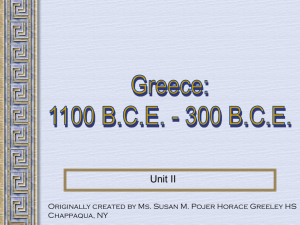
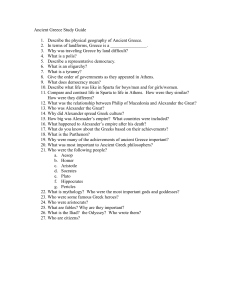


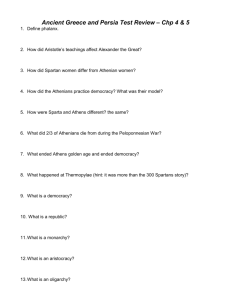

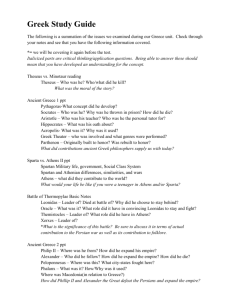
![Greece_ICS[1]](http://s3.studylib.net/store/data/009468431_1-e3860e59daf5532e9ba8da0246fc4aa0-300x300.png)
